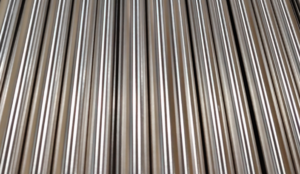High-speed steel (HSS) and plain steel, as two commonly encountered steel types, play diverse roles in daily life despite exhibiting marked differences in their properties. In this article, we will take a closer look at the differences between high-speed steel and plain steel.

5 Differences Between High-Speed Steel and Plain Steel:
Firstly, regarding hardness and strength, HSS stands out due to the substantial inclusion of alloying elements such as tungsten, molybdenum, chromium, and vanadium during its manufacture. These elements form hard carbides within the alloy, significantly enhancing its strength and hardness. In contrast, plain steel boasts a simpler composition with fewer alloying elements, resulting in inferior strength and hardness compared to HSS. Typically, HSS can achieve a hardness value exceeding HRC60, whereas plain steel’s hardness generally ranges between HRC20 and HRC40.
Secondly, there is a notable difference in red hardness. HSS exhibits high red hardness, retaining substantial hardness even at elevated temperatures. Specifically, at 600°C, its hardness remains around HRC63. Conversely, plain steel, while maintaining good hardness at room temperature, experiences a sharp decline in red hardness when temperatures exceed 200°C, making it unsuitable for high-temperature applications.
Thirdly, toughness differs significantly. Higher carbon content in steel typically leads to increased hardness but decreased toughness. Plain steel, with its lower carbon content and more uniform microstructure, can better absorb energy under external impact or deformation, demonstrating superior toughness. HSS, on the other hand, despite its ability to resist shock and vibration to some extent due to its higher carbon content, typically exhibits lower toughness.
Furthermore, wear resistance is another key distinction. Generally, the higher the hardness of steel, the better its wear resistance. HSS, with its elevated carbon content and alloying elements like molybdenum and tungsten, possesses superior wear resistance compared to plain steel.
Lastly, machinability differs between the two. The machinability of HSS is heavily influenced by its chemical composition and heat treatment process. The abundant alloying elements in HSS significantly enhance its hardness, wear resistance, and red hardness but also increase machining difficulty, often requiring specialized heat treatment for improved machinability. Conversely, plain steel, with fewer alloying elements, generally exhibits good machinability and can often be used without further heat treatment.
Summary
In summary, HSS excels in overall performance, making it the preferred choice for manufacturing cutting tools such as lathe tools, drills, hobs, milling cutters, broaches, and gear cutters. While plain steel may not match the performance of HSS, its lower production cost and suitability for large-scale production render it widely used in engineering construction, automotive manufacturing, and other fields. Ultimately, the choice between these two materials should be based on specific application requirements and economic considerations.
Why Choose Sino Special Metal?
Thank you for reading our article and we hope it can help you to have a better understanding of the differences between high-speed steel and plain steel. If you are looking for suppliers and manufacturers of high-speed steel, we would advise you to visit Sino Special Metal.
As a leading supplier of spring steel from Shanghai China, Sino Special Metal offers customers high-quality M2 High-Speed Steel, M35 High-Speed Steel, and M42 High-Speed Steel at a very competitive price.




